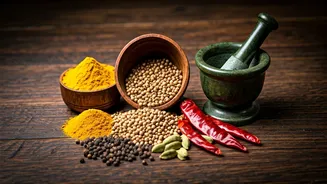A Culinary Tapestry
Indian cuisine is a vibrant mosaic of regional flavors, influenced by a rich history and diverse cultures. From the spice-laden curries of the South to the tandoori
delights of the North, each area boasts unique dishes and cooking methods. The use of spices, herbs, and fresh ingredients is central, with each spice carefully chosen for its flavor and medicinal properties. Moreover, the historical influence of trade, migration, and invasions has shaped Indian food, with elements from Persian, Portuguese, and British cuisines now an integral part of the culinary landscape. Traditional cooking techniques like slow-cooking in earthen pots and the use of tandoors add to the unique flavors and textures of the food. Indian food, beyond mere sustenance, is a celebration of life, community, and cultural identity.
Iconic Regional Dishes
India's diverse geography and cultural landscape have given rise to a wide array of iconic dishes, each representing its region's unique identity. In the North, butter chicken and naan symbolize culinary excellence, while the South offers the complex flavors of dosa, idli, and sambar. The West boasts the fiery vindaloo and the sweet delights of modaks, reflecting the influence of the Portuguese. The East is known for its sweets and the delicate flavors of Bengali cuisine, especially fish preparations and the famous rasgulla. Many dishes, like biryani, have evolved differently across regions, each adapted to local preferences and ingredients. The regional variations in dishes highlight the country's incredible culinary diversity and showcase the ingenuity of home cooks and chefs who have preserved and innovated upon these treasured recipes over generations.
Spices: The Soul
Spices are the heart and soul of Indian cuisine, not only enhancing the flavor but also serving cultural and medicinal functions. From turmeric, known for its anti-inflammatory benefits, to cumin, which aids digestion, spices are essential ingredients. Every spice blend is carefully made, based on precise proportions passed down through generations. The preparation of these spice blends is an art, with each family possessing its own unique recipe. Spices like cardamom, cloves, and cinnamon add warmth and complexity to dishes. They are used in various forms – whole, ground, or roasted – to provide depth and aroma. Moreover, spices influence the color and texture of the food, adding to the sensory experience of eating. They also represent the country's rich trading history, with spices like pepper and saffron once being highly sought-after commodities from India.
Street Food Wonders
India's street food is a must-try culinary experience, a testament to the country's vibrant culture. Each city and town has its own unique street food offerings. From the savory chaat in Delhi to the spicy pav bhaji in Mumbai, street food is a reflection of the diverse regional tastes. It's known for its affordability, delicious flavors, and the communal experience of eating. The street food is made with fresh ingredients and often prepared in front of customers. It is a source of pride for local vendors. Beyond the well-known dishes, each area offers hidden culinary gems, like the momos of the northeast or the kachoris of Rajasthan. The popularity of street food has also influenced the growth of food stalls, restaurants, and food delivery services, which have made it easier for people to enjoy these culinary treasures.
Feasts and Celebrations
Food plays a vital role in Indian festivals, weddings, and special occasions, reflecting cultural values and beliefs. Celebrations are associated with feasts that feature a wide array of dishes, each with unique symbolism. Weddings are grand events, with elaborate menus tailored to regional traditions. Festivals like Diwali and Eid are filled with sweets, savory snacks, and special meals. The sharing of food also promotes social connections, strengthening family and community ties. The dishes are not just about taste, but also the stories and traditions behind each recipe. Regional specialties are often cooked using techniques and ingredients that reflect local customs, adding depth to the celebrations. These food-centric traditions highlight the importance of food as a unifying force that embodies India’s rich cultural heritage.



